Timing is everything. Just ask that burnt souffle sitting in your oven. It probably wishes you had better timing. Being in the right place at the right time can not only alter the course of one’s dessert menu, but also their whole life. If you’re an online advertiser, the same goes for your business. That’s why we love in-market audiences so much. (Almost as much as a well-cooked souffle.)

Puff pastries aside, let’s focus our attention on how to boost sales with better-timed ads.
When advertisers go to bed at night, they dream of one thing: delivering a perfectly tailored message to a prospect at the exact moment they’re ready to take action. We know what you’re thinking — advertisers have really boring dreams. But it’s the right kind of dream to have if you find yourself knee-deep in bidding strategies and audience targeting all day long.
The good news? We’re about to make those dreams come true. Or at least show how Google can, with their in-market audiences.
So set your watches to “sell” because we’re about to optimize your timing.
Using In-Market Audiences to Capitalize on Purchase Intent
Digital marketing has always been about understanding behavior and intent. But this focus is important now more than ever. Just look at the crazy impact of Google’s BERT update on search — where intent usurped the almighty keyword as the best way to match content with queries.
Similarly, understanding intent is revolutionizing the online ad space.
In-market audiences are groups of users that demonstrate a high likelihood of purchasing what you’re selling. These audiences are collected by analyzing browsing behavior, like the websites they visit, the ads they click, and the content they read to help determine what products they are “in-market” for.
In other words, in-market audiences’ past behavior is used to predict future purchasing, which is not only cool, but incredibly useful.
Not sold yet?
What could be better than having an ad shown directly to a customer who is actively looking for a product or service you provide? How about having an ad served to a customer who is ready to purchase a product or service you provide.
That’s where in-market audiences shine.
Google lets you set in-market audiences as a targeting method in your Google Ad campaigns. (Bing also lets you use in-market audiences, and although we’ll focus specifically on Google here, implementation is very similar on either platform.) Google will then show your ad to people who are most likely to click through and convert.
Why?
Because based on their online activity up to that point, that particular user has shown a very high probability of taking the exact action you want them to.
Pretty sweet, right? Google does all the work, and you swoop in at the last moment to save the day (and make a sale).
Goodbye Sales Funnel, Hello Sales Driver
What makes in-market audiences so special (and valuable) is that they connect you with consumers on the final stages of the sales funnel, where they are more likely to make a purchase.
That’s the golden goose of sales stages.
The very top of the sales funnel comprises all those people who might purchase your product. The mid and lower stages of the sales funnel comprise those who want to buy your product. Getting a customer to take the journey from top to bottom, and weeding out those who will never pull the trigger and make a purchase, is time-consuming and costly.
So what if you could skip all that tedious work of leading your customers down the funnel, and jump right to the good part where they buy stuff and you make money?
In-market audiences to the rescue!
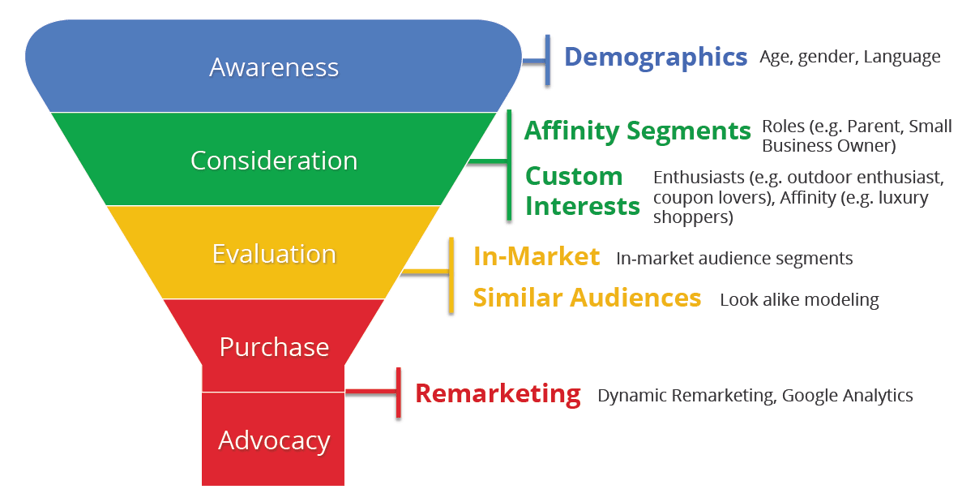
With in-market audiences, the part of the sales process where you must greet, listen, and determine the buyer’s needs is already done. That’s because the audience is comprised of users who have already “bought in.” Now all you have to do is close the sale.
So, in essence, in-market audiences serve up purchase-ready customers on a silver platter. Your ads get shown to those who have already made the decision to purchase and are just looking for the right opportunity to do so. Lucky for them, you’re that opportunity.
Best of all, by using in-market audiences, you spend a lot less time, money, and resources marketing to people at the top of the sales funnel. And what does that spell? A high R-O-I!
But enough talk about the benefits of in-market audiences. Time is money, and these audiences aren’t going to sell to themselves.
So let’s get down to business and get your awesome ads in front of them already…
How to Set Up In-Market Audiences in Google Ads
Here all the steps you need to set up an in-market audience campaign in Google Ads.
- Sign in to Google Ads
- Select “Audiences” in the left menu
- Hit the “New Audiences” plus sign at the bottom or blue pencil button
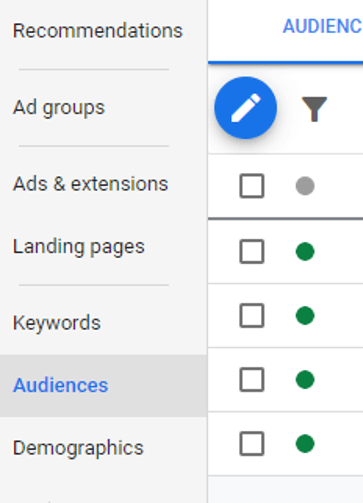
- In the dropdown choose to “Add to” a campaign or ad group
- Select the campaign or ad group you want to assign the audience
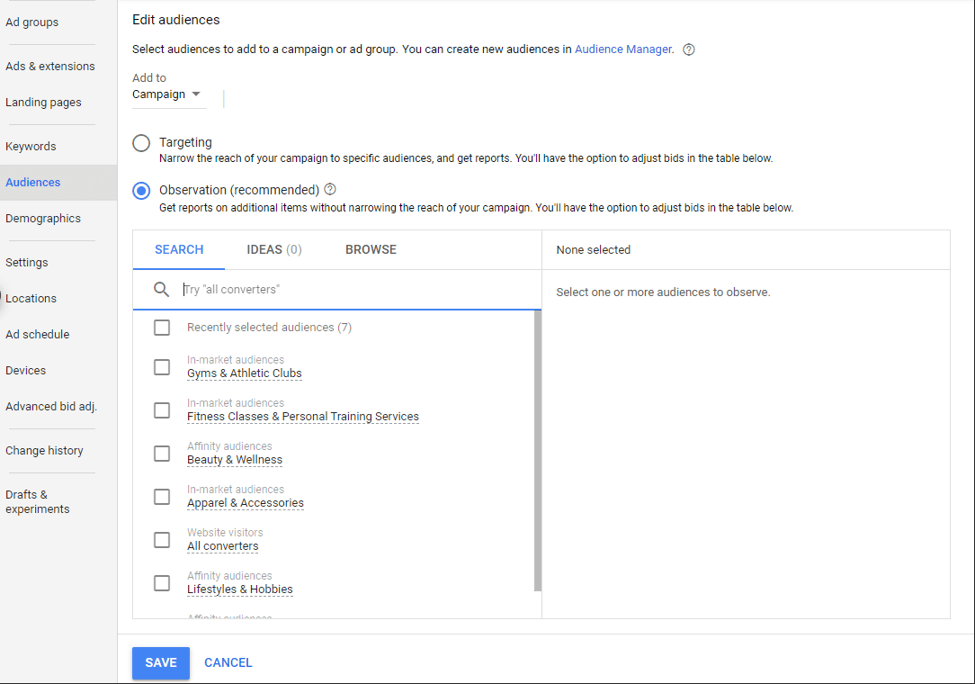
- Choose between “targeting” or “observation” mode
Observation broadens the reach of your ad to see how it performs on a larger scale while allowing you to still set bids specifically to your chosen audience. Targeting narrows the reach of your ad to only those in your chosen audience and no one else. (In Bing, these are called “target and bid” and “bid only.”) If you’re unsure which to use, try A/B testing an ad group using “targeting” versus one using “observation” and see which provides better results. - Find the audience category or product that best matches your offering
There are two ways to find in-market audiences. In the table, you will see tabs for “Search” and “Browse.” Under Search, you can enter your specific product or the topic of your ad, and Google will provide recommended in-market audiences for you to choose from.
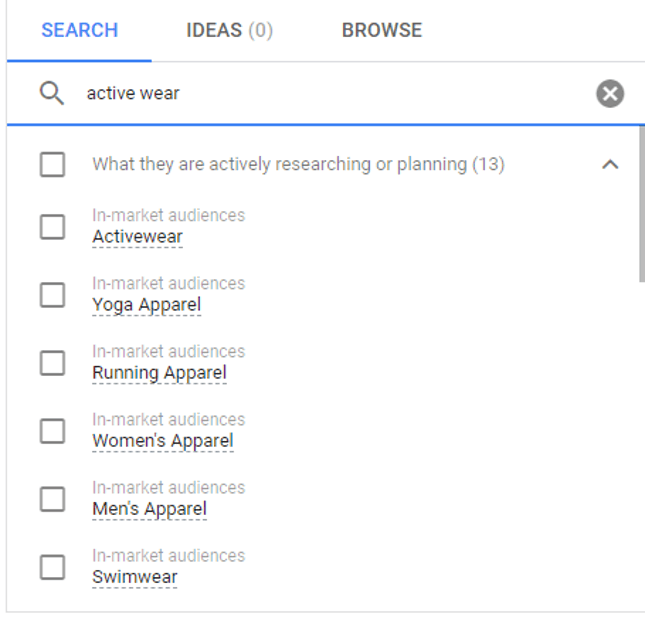
Under Browse, you start by telling Google the type of audience behavior you’re interested in. (For in-market audiences select, “What they are actively researching or planning.”) You then navigate through category dropdowns to find the best possible in-market audience for your ad.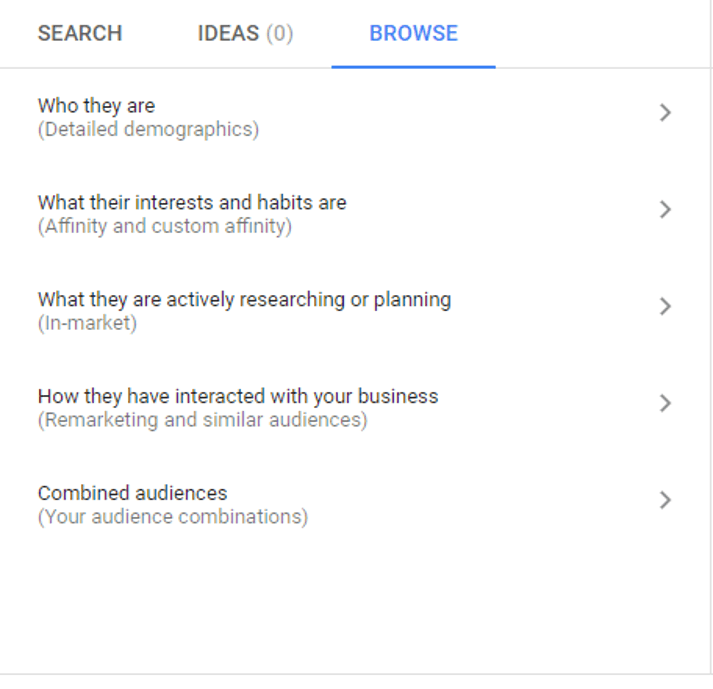
Once you find the perfect audience: - Select the in-market audience
- Hit “Save”
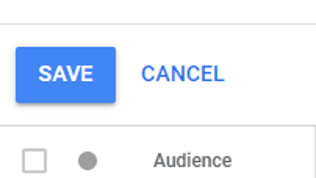
Congratulations! You’ve set up an in-market audience for your ads.
Wait, what’s that sound?
Oh, that’s just customers knocking on your door to buy things.
But before you get too excited, a few pearls of wisdom:
Pearl #1: Remember to take special care when picking your campaign or ad group (step #4). If you have multiple ad groups in a campaign with different messaging, you might want to start at the ad group level. If you choose a campaign, then in-market audience targeting will be applied to all of your ad groups within that campaign.
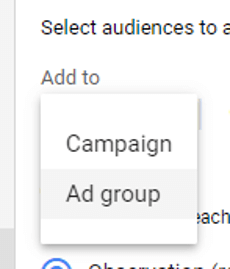
Pearl #2: Also, avoid choosing campaigns or ad groups with other targeting options already assigned. For example, don’t have an ad group target both an in-market audience and keywords at the same time. Set up a separate ad group for each. (As a bonus, this is a great way to A/B test different ad targeting methods.)
Pearl #3: Likewise, try to avoid selecting multiple audience types. For instance, don’t use affinity audiences and in-market audiences together. The point here is to target your ads better, not muddy the waters with different audience types.
Setting up an in-market audience is good and all, but you know what’s even better?
Optimizing In-Market Audiences to Boost Sales Beyond Your Wildest Dreams
Tip 1: Use CPA Bidding
Cost per thousand impressions (CPM) bidding is ideal for targeting potential customers at the top of the sales funnel. However, the farther you get toward the bottom of the funnel, the more refined your bidding strategy should become.
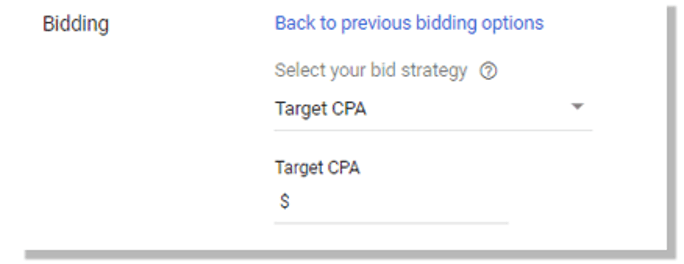
For in-market audiences, try using cost per acquisition (CPA) bidding. CPA bidding’s sole goal is to maximize sales by getting your ad as many conversions as possible.
There are exceptions, of course. But since in-market audiences have high purchase intent, you should test a CPA bidding strategy.
Tip 2: Layer Targeting
Google’s machine learning is frighteningly impressive, but no one knows your customers better than you.
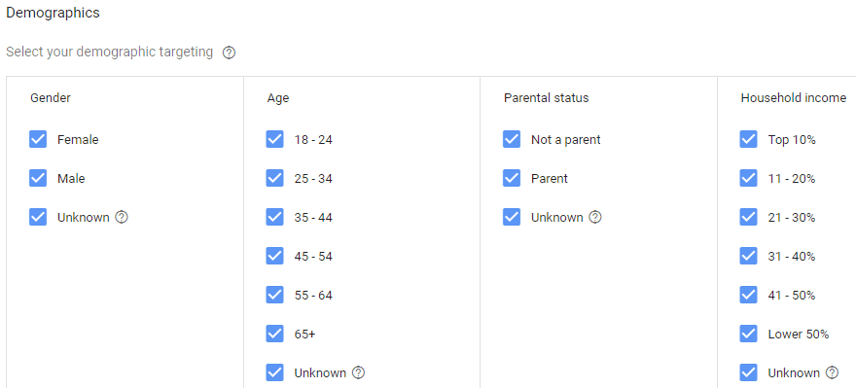
Further improve your in-market audiences by adding multiple layers of hyper-focused demographic and geographic targeting. By putting into action all the data you’ve gathered about your ideal customer persona (ICP), together with Google’s AI, you’ll become the dynamic duo of selling.
Tip 3: Don’t Underestimate Your Competition
In-market audiences have been around for a while, which means the word is out, and you won’t be one of the few taking advantage.
Expect to face some stiff competition, especially since building in-market audiences relies on finding people who have shown previous interest in your competitors.
In fact, your ad spend could go up in highly competitive markets.
As competition grows, so too will your costs. Be sure you’re ready to throw your hat into the ring when implementing in-market audiences.
How can you get battle-ready?
Start with excellent competitor research.

Don’t make the mistake of thinking you don’t have any competitors. They’re out there. Our competitor analysis guide can help you find them. Once you do, you can come up with brilliant ways to top them.
Like…
Tip 4: Give Your Audience an Offer They Can’t Refuse
Picking the perfect in-market audience alone will not ensure success.
First and foremost, you want to have a superior product. Ideally, one that practically sells itself.
Short of that, you want to have great messaging. Not good messaging. Not pretty good messaging. AMAZING messaging. Messaging so appealing people have no choice but to click it. Take the infamous DeBeers campaign for example.

Focus on pain points and offer a firm solution. If you have a promotion or any other deal that will make an ad more enticing to click, go for it! Create a sense of urgency and a timeframe. Remember, your competitors are in this landscape, too, so demonstrate what sets you apart.
We’ve outlined several strategies for crafting compelling, sales-driven copy for your ads.
Last, but certainly not least, prime your landing page to convert. Your offer is more than just a single headline or CTA. It is the entire experience of your ad campaign. So, create an experience that capitalizes on the purchase intent of your audience every step of the way.
Tip 5: Start Branding Before They’re Ready to Buy
Remember the movie Inception? You probably thought it was about watching Leonardo DiCaprio navigate dreams and spin tops. But it was actually about digital marketing.

You see, the premise revolves around inserting ideas into people’s minds so they willingly take a desired action in the future. Or as we like to call it creating “brand awareness.”
And it’s something you should consider when using in-market audiences.
Because even though in-market audiences let you skip ahead and target people at the later stages of the sales funnel, you shouldn’t ignore them when they’re at the top. In fact, early investing in brand awareness campaigns will only enhance the sales effectiveness of your later in-market ad campaigns.
Remember, in-market audiences are not a get rich quick scheme. They are a single (albeit kickass) component of your larger paid media strategy.
So channel your inner-DiCaprio and get your customers loving your products before they even know they exist.
Tip 6: Exclude In-Market Audiences
In-market audiences aren’t just for targeting potential customers. They are also for eliminating non-customers.
Excluding PPC audiences is one of the most effective ways to improve ROI in an ad campaign. To do this in Google, click into the “exclusions” tab and select the “add filter” button (as seen below).

Sometimes you might not be able to find an in-market audience that perfectly matches your offer. Sometimes you’ll need to refine your targeting further. In these cases, try excluding irrelevant in-market audiences that you don’t want engaging with your ad.
For example, if you are selling used cars, it’s a good idea to exclude anyone looking for new cars.
Tip 7: Don’t Stop Believing (or Monitoring Performance)
As is, in-market audiences are incredibly powerful. But there’s always room for improvement.
So don’t get down if you target an in-market audience and don’t see immediate results. There’s still value to be had in analyzing performance, regardless if it’s good or bad.
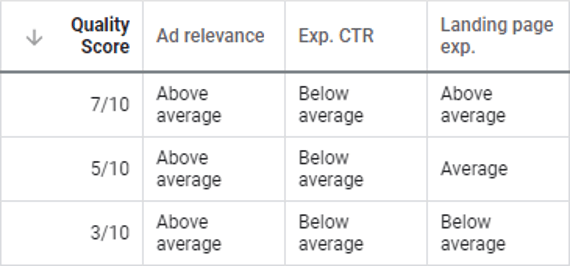
Start by looking at your Quality Score to make sure your ad is actually appearing.
Then take a look at CTR. If click-through-rate is lower, then you might want to improve your ad copy, or A/B test different in-market audiences against one another. For instance, your ad might be appearing in front of the wrong audience, or the audience needs to be further refined by excluding other audiences.
If you have a high CTR but no one’s buying your product, then your landing page probably needs some work. Make sure you’re following the 12 steps to doing CRO like a pro.
If, after all that, your ROI is still too low, try testing between “targeting” and “observation” modes, and different bidding strategies (e.g., CPA versus CPC).
Monitor and compare performance from any changes, and once you find a winning combination that works, go all in.
Conclusion — Sell Better with In-Market Audiences
Why consumers decide to buy a product has been a code online advertisers have been trying to crack since the beginning of time or at least the Internet.
With in-market audiences, we’re closer than ever.
There are a lot of buyers out there hungry for what you’re selling. All you have to do is be there at the right place and time. That’s why we recommend giving in-market audiences a try to boost your sales and give the people what they want.
You might just find you get what you want as well.


